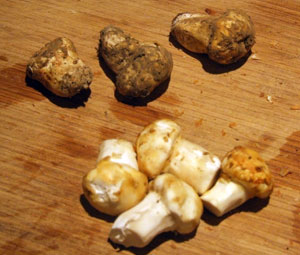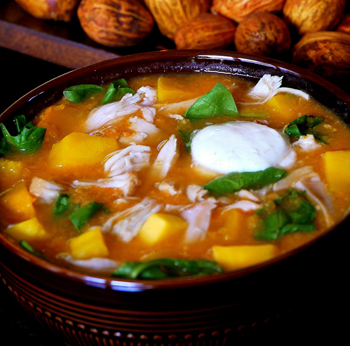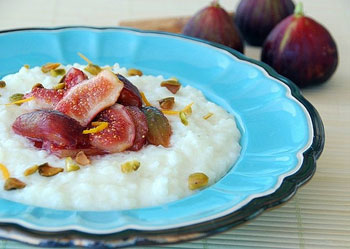 One night last week Jeff came home from work and handed me a bag from his clinic. I thought, "Yes! More free anti-wrinkle cream!" (Having a dermatologist as a husband does have its advantages). When I peeked inside the bag, however, I discovered something even better than antioxidant cream: a dozen plump, brilliant green figs that were beginning to split from ripeness. "Wow! Where did you get the fresh figs?" I asked. "Adel gave them to me from the tree in her yard," he said.
One night last week Jeff came home from work and handed me a bag from his clinic. I thought, "Yes! More free anti-wrinkle cream!" (Having a dermatologist as a husband does have its advantages). When I peeked inside the bag, however, I discovered something even better than antioxidant cream: a dozen plump, brilliant green figs that were beginning to split from ripeness. "Wow! Where did you get the fresh figs?" I asked. "Adel gave them to me from the tree in her yard," he said.
Adel, who works with Jeff, told him, "Last year my tree produced three figs. One for me, one for my husband, and one for the birds." Fortunately she's having a bumper crop this season, and we're two of the lucky beneficiaries.
To celebrate fall's arrival, I'm sharing a recipe for Dessert Risotto with Wine Poached Figs. Arborio rice, which is used to make risotto, makes the most luxurious rice pudding imaginable: it's plump, tender, and creamy. Topping it with perfumed, wine-poached figs adds elegance and sweetness, resulting in a remarkably velvety, rich pudding.

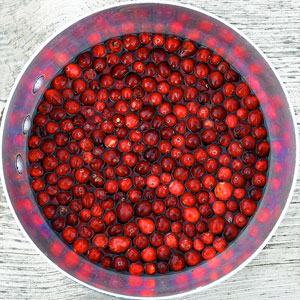 When I was a kid and my parents took us out for breakfast, I always ordered a glass of cranberry juice. I loved the way it sparkled like rubies in a glass. But most of all, I loved its mouth-puckering tartness that sent shivers down my jaws when I drank it. (Even typing that sentence caused the same reaction.)
When I was a kid and my parents took us out for breakfast, I always ordered a glass of cranberry juice. I loved the way it sparkled like rubies in a glass. But most of all, I loved its mouth-puckering tartness that sent shivers down my jaws when I drank it. (Even typing that sentence caused the same reaction.) No, this is not a picture of a sea anemone. It's spaghetti squash. And though my mom doesn't like it, she makes it all the time for my dad since it's his favorite type of squash. Her favorite, by the way, is buttercup. I know this because the three of us have the same conversation every year as if it's a revelation:
No, this is not a picture of a sea anemone. It's spaghetti squash. And though my mom doesn't like it, she makes it all the time for my dad since it's his favorite type of squash. Her favorite, by the way, is buttercup. I know this because the three of us have the same conversation every year as if it's a revelation: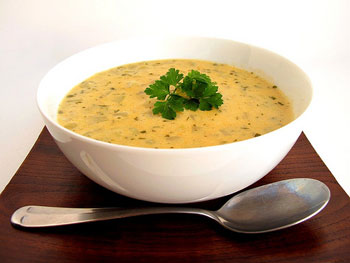 Kohlrabi, a vegetable that sounds just as foreign as it is alien to most people, is a subtle-flavored vegetable in the cabbage family. In fact it's German name translates to cabbage (kohl) turnip (rabi). Varieties include purple and pale green. It often gets confused with rutabagas or turnips, but it's actually much more attractive than both. Kohlrabi can be eaten raw (its taste resembles that of radishes) or cooked (where its taste is similar to boiled broccoli stems). This creamy soup is the perfect recipe for kohlrabi, because the vegetable turns sweet and tender.
Kohlrabi, a vegetable that sounds just as foreign as it is alien to most people, is a subtle-flavored vegetable in the cabbage family. In fact it's German name translates to cabbage (kohl) turnip (rabi). Varieties include purple and pale green. It often gets confused with rutabagas or turnips, but it's actually much more attractive than both. Kohlrabi can be eaten raw (its taste resembles that of radishes) or cooked (where its taste is similar to boiled broccoli stems). This creamy soup is the perfect recipe for kohlrabi, because the vegetable turns sweet and tender.